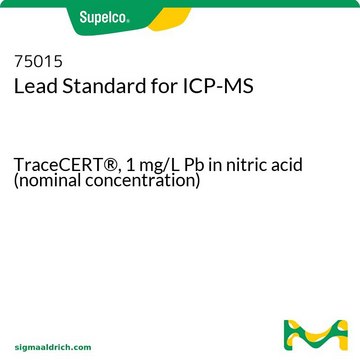180173
Disulfuro de carbono
ACS reagent, ≥99.9%
About This Item
Productos recomendados
grado
ACS reagent
densidad de vapor
2.67 (vs air)
presión de vapor
5.83 psi
Ensayo
≥99.9%
Formulario
liquid
temp. de autoignición
212 °F
lim. expl.
50 %
dilution
(for analytical testing)
impurezas
H2S, passes test (lim. ~1.5 ppm)
SO2, passes test (lim ~2.5 ppm)
≤0.05% water
residuo de evap.
≤0.002%
color
APHA: ≤10
índice de refracción
n20/D 1.627 (lit.)
bp
46 °C (lit.)
mp
−112-−111 °C (lit.)
densidad
1.266 g/mL at 25 °C (lit.)
cadena SMILES
S=C=S
InChI
1S/CS2/c2-1-3
Clave InChI
QGJOPFRUJISHPQ-UHFFFAOYSA-N
¿Está buscando productos similares? Visita Guía de comparación de productos
Categorías relacionadas
Descripción general
Aplicación
It may be used in the preparation of dibenzyl trithiocarbonate, a RAFT (Reversible Addition-Fragmentation Transfer) chain-transfer agent (CTA). It may be employed as a solvent in the preparation of benzyl chlorodithioformate.
Envase
Producto relacionado
Palabra de señalización
Danger
Frases de peligro
Clasificaciones de peligro
Acute Tox. 4 Inhalation - Eye Irrit. 2 - Flam. Liq. 2 - Repr. 2 - Skin Irrit. 2 - STOT RE 1
Órganos de actuación
Peripheral nervous system,Central nervous system,Cardio-vascular system,Eyes
Código de clase de almacenamiento
3 - Flammable liquids
Clase de riesgo para el agua (WGK)
WGK 2
Punto de inflamabilidad (°F)
-22.0 °F - closed cup
Punto de inflamabilidad (°C)
-30 °C - closed cup
Elija entre una de las versiones más recientes:
¿Ya tiene este producto?
Encuentre la documentación para los productos que ha comprado recientemente en la Biblioteca de documentos.
Nuestro equipo de científicos tiene experiencia en todas las áreas de investigación: Ciencias de la vida, Ciencia de los materiales, Síntesis química, Cromatografía, Analítica y muchas otras.
Póngase en contacto con el Servicio técnico







